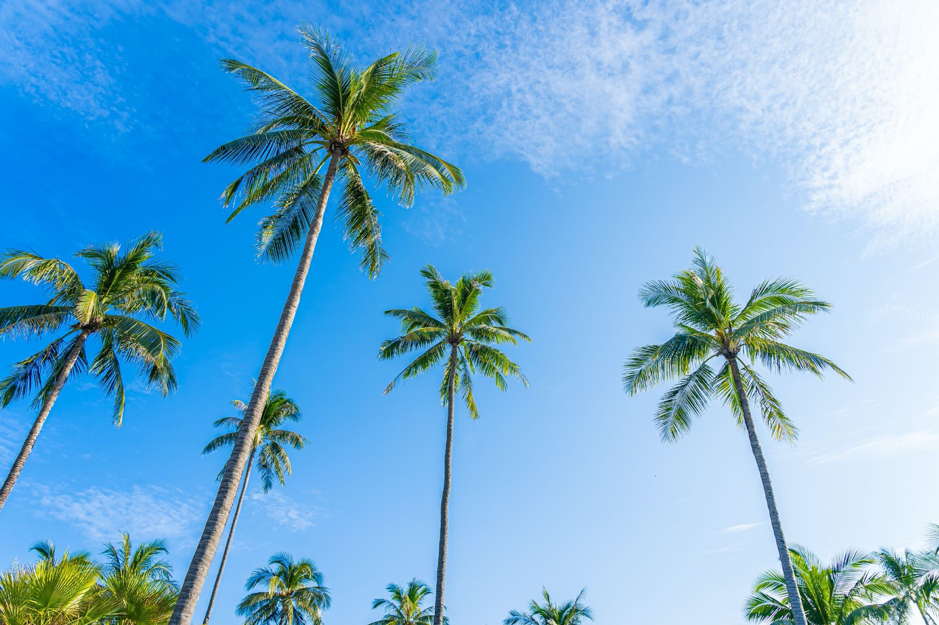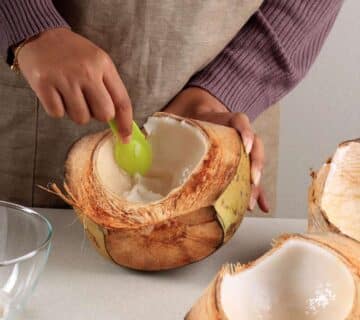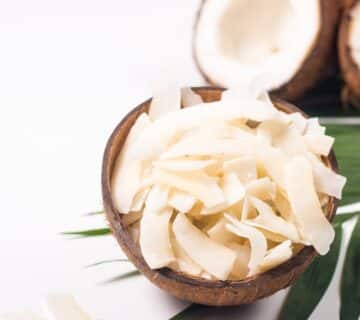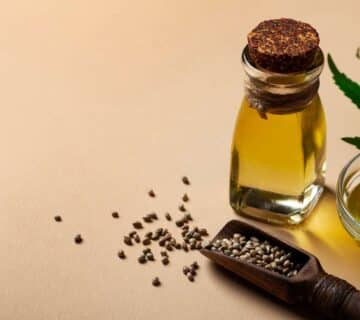In Indonesia, coconut trees stand as emblematic symbols of tropical beauty and abundance. These majestic palms come in various forms, each with its unique characteristics and purposes.
Indonesia’s coconut trees are incredibly diverse. In this article, we will explore the different types of coconut trees found in Indonesia, each with its unique characteristics and uses.
Different Types of Indonesia Coconut Tree You Should Know
Before delving into the specifics, let’s establish a foundational understanding of the coconut family. In Indonesia, coconut is called ‘kelapa’. So most of the Indonesia coconut trees will have the ‘kelapa’ in their name.
For your further understanding, here are the different types of Indonesian coconut trees, their specifications, and the roles they play in the lives of the Indonesian people.
1. Kelapa Gading – The Ivory Coconut Tree
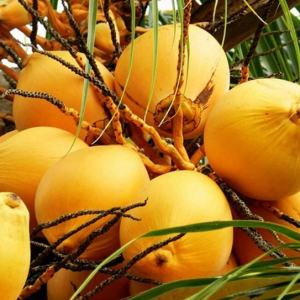
The first type of Indonesia coconut tree is the Kelapa Gading, also known as the Ivory Coconut Tree. This variety is named for its pale ivory-colored coconuts, which are highly popular for their sweet and refreshing water.
Kelapa Gading is commonly found in more or less rural rice fields. Farmers commonly plant it in rice fields for shade plants because it is easy to grow and produces rich fruit.
Coconut ivory will fruit at the age of three years, and the price of the fruit is relatively low. Even though it’s inexpensive, people still love it because the water content offers incredible health advantages.
Specifications
- Fruit Color: Ivory
- Taste: Sweet and refreshing
- Common Use: Beverage and dessert
2. Kelapa Hijau – The Green Coconut Tree
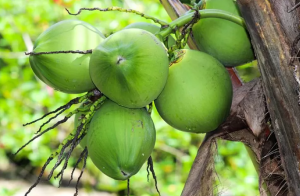
Next, we have the Kelapa Hijau, or Green Coconut Tree. These coconuts are in a vibrant green color because they are harvested before they ripen.
Green coconut is in high demand since it has been shown to be effective in preventing and treating a variety of disorders. One of which is neutralizing toxins in the bodies of persons who have food poisoning.
Furthermore, the shell and its fibers are widely employed in handicrafts, household items, and basic building components.
Specifications
- Fruit Color: Green
- Taste: Mild and slightly sweet
- Common Use: Coconut water, cooking, and handicrafts
Related Article: What are Dry Coconuts, Their Uses, and Derivative Products?
3. Kelapa Pandan – The Pandan Coconut Tree
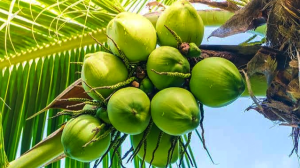
Next Indonesia coconut tree type is the Kelapa Pandan, or Pandan Coconut Tree. These coconuts have a unique pandan leaf aroma, making them a culinary delight.
The pandan coconut requires intensive daily care. That’s why the grains and seeds are so pricey and hard to be planted in ordinary yards.
This type of coconut has short stature, with a maximum height of only 3 meters. But it does not prohibit it from bearing fruit to its full capacity. It has been demonstrated that this species of coconut tree may yield fruit at the age of three years, far faster than regular coconuts.
In terms of cost, the aromatic pandan coconut fruit is up to ten times more expensive because it is difficult to care for and not everyone can cultivate it.
Specifications
- Aroma: Pandan leaf
- Taste: Aromatic and mildly sweet
- Common Use: Pandan-flavored dishes and desserts
4. Kelapa Kopyor – The Kopyor Coconut Tree
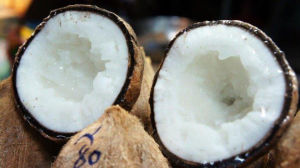
The Kelapa Kopyor, or Kopyor Coconut Tree, is known for its unusual fruit, which contains a gel-like substance instead of solid coconut meat. This variety is a rare find and many people highly search for it.
The barrier between the flesh of the fruit and the inner shell wall is referred to as kopyor. As a result, the coconut flesh pulls off easily and is sensitive and gentler.
Kopyor coconut is highly good as a drink to boost stamina, cure dengue fever, restore burns, alleviate skin irritation, and many other things.
Currently, kopyor coconut is commonly used as a drink in many restaurants and hotels, where it is mixed with a variety of other fruits to add a diversity of flavors. Because of the increased demand for kopyor coconut, the price has risen and it is now more expensive and scarce than other types of coconut.
Specifications
- Fruit Texture: Gel-like
- Taste: Unique and exotic
- Common Use: Special desserts and beverages
5. Kelapa Genjah Entok – The Duckbill Coconut Tree
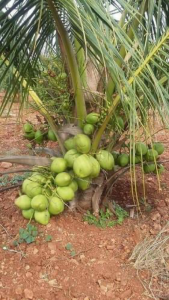
The Kelapa Genjah Entok, or Duckbill Coconut Tree, gets its name from the distinctive shape of its coconuts, which resemble a duck’s bill. These coconuts are valued for their novelty.
Like the aromatic pandan, this early coconut is a variety of coconut with a short posture that produces fruit faster than others.
The fruit is smaller than other coconuts, and the trunk of the coconut tree is comparatively short, measuring maximum only 2-4 meters. This coconut cannot grow taller than 8 meters when mature and productive, because the older the tree, the broader the diameter of the trunk.
This tree is commonly planted as a decorative plant in household gardens, and some are also established as plantations. Because of the distinctiveness of the tree and its color, this type of coconut is currently in high demand.
Specifications
- Fruit Shape: Resembles a duck’s bill
- Taste: Mild and sweet
- Common Use: Decorative purposes and unique presentations
Related Article: 10 Health Desiccated Coconut Benefits For Your Body
6. Kelapa Merah Wulung – The Red Coconut Tree

Last, we have the Kelapa Merah Wulung, or Red Coconut Tree. These coconuts stand out due to their reddish husk and they offer a delightful taste.
Because of its enormous and round fruit, this variety of coconut tree is considerably larger than other varieties of coconut trees.
Pregnant ladies frequently use it as a natural energy source. It turns out that it can be an antidote to toxins that have entered a person’s body, and it has many other benefits.
This type of coconut is greatly sought after for cultivation by businesses and farmers. Aside from its high financial value, this tree has a lot of appeal in terms of use.
However, not just anyone can produce wulung coconut. It takes experience and flight hours to ensure good harvests and quality.
Specifications
- Fruit Color: Reddish
- Taste: Sweet and nutty
- Common Use: Aesthetic purposes, natural energy drink and traditional ceremonies
In Searching For Coconut Suppliers?
The diverse range of Indonesia coconut tree types exhibit remarkable diversity, both in appearance and utility. From the sweet and refreshing Kelapa Gading to the visually stunning Kelapa Merah, each variety brings its unique charm to the Indonesian landscape.
If you are looking for a reliable exporter of top-quality coconut products, you can contact Sari Coconut. They offer a wide range of coconut products, all with the finest quality.
With Sari Coconut as your partner, you can enjoy the peace of mind that comes with working with a reliable and professional supplier. Learn it here on how to buy coconut products from Indonesia. You can also contact them for further information!
Related Article : How Does Coconut Influence the Economy & Culture of Indonesia?
FAQ
Are all Indonesian coconut trees suitable for consumption?
While most Indonesian coconut trees produce coconuts that can be consumed, the taste and texture may vary. Some are better suited for culinary purposes, while others are primarily used for other applications.
Where can I find the Kelapa Kopyor variety in Indonesia?
Kelapa Kopyor is relatively rare, but you can find it in select regions of Indonesia, particularly in specialty markets and restaurants that specialize in exotic dishes.
What are the different types of coconuts in Indonesia?
There are several types of Indonesia coconut tree, starting from kelapa gading, kelapa hijau, kelapa pandan, kelapa kopyor, kelapa genjah entok and kelapa merah wulung.
Do all coconut trees in Indonesia have the same growth requirements?
No, different coconut tree varieties may have slightly different growth requirements, including soil type, climate, and water needs. It’s essential to consider these factors when cultivating specific coconut varieties.
Can I grow Indonesian coconut trees in my home garden?
Yes, many Indonesian coconut tree varieties, especially dwarf varieties like Kelapa Dalam, are suitable for home gardens. However, it’s essential to research their specific care requirements to ensure healthy growth.

